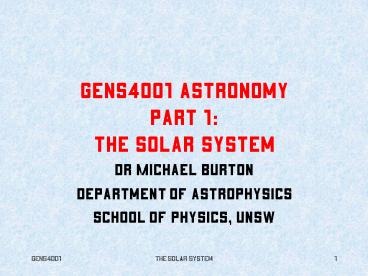GENS4001 Astronomy Part 1: The Solar System - PowerPoint PPT Presentation
1 / 14
Title:
GENS4001 Astronomy Part 1: The Solar System
Description:
Jupiter, Saturn, Uranus, Neptune. Pluto / Charon. 61 Moons ... Moons of Jupiter. 16 Moons with 4 giants (Galilean satellites) ... – PowerPoint PPT presentation
Number of Views:106
Avg rating:3.0/5.0
Title: GENS4001 Astronomy Part 1: The Solar System
1
GENS4001 AstronomyPart 1The Solar System
- Dr Michael Burton
- Department of Astrophysics
- School of Physics, UNSW
2
Overview
- 1 Star (the Sun)
- 8 1 Planets
- Mercury, Venus, Earth, Mars
- Jupiter, Saturn, Uranus, Neptune
- Pluto / Charon
- 61 Moons
- 100,000 (?) Asteroids, 100 million (?) Comets,
Solar Wind
3
Formation of the Solar System
- Collapse of cloud of gas, dust ice
- 4.6 billion years ago,
- Swirling, disk-shaped,
- Sun formed at centre of Solar Nebula.
- Inner planets form through accretion of dust
particles to planitesimals into protoplanets. - Collisions cratering dominate for 150 Myrs.
- Outer planets form through accretion of gas onto
rocky protoplanetary cores.
4
Our Star, the Sun
- Giant ball of plasma undergoing thermonuclear
fusion of hydrogen in centre! - Photosphere - visible surface at 6000C
- Chromosphere
- Jets of gas (spicules) rise along along
boundaries of granules. - Corona - tenuous, hot (2,000,000C) gas
- Blends into Solar Wind
5
The Sun (continued)
- Surface features vary with 11-year cycle
- Sunspots cooler with strong magnetic field,
- Solar flare eruption from sunspot group,
- Convection cells, transporting energy outwards.
- Energy produced by thermonuclear fusion of 4
H-atoms into He-atom at 8 million C. - Solar Model well understood
- Fusion in core about 1/4 solar radius in size,
- Neutrinos - 1/4 predicted number?
6
Earth / Moon
- Double planet system, tidally interacting.
- Plate Tectonics produces continents, oceans,
mountains volcanoes. - Iron rich core producing magnetic field.
- Atmosphere of 80 nitrogen, 20 oxygen
- Troposphere, stratosphere, mesosphere,
thermosphere - Supports life on land, oceans atmosphere.
7
Earth / Moon (continued)
- Magnetosphere surrounding Earth, protecting
atmosphere from Solar Wind. - Collision-ejection with giant asteroid, with
debris coalescing to form Moon. - Weathering has erased asteroid impacts on Earth
but past history still visible on Moon. - Cratered highlands,
- Smooth-surfaced Maria, from lava flows.
8
Earth / Moon Phenomena
- Phases of the Moon
- Orbit about Earth, and Solar illumination.
- Eclipses when Sun/Earth/Moon in line
- Lunar eclipses
- Solar eclipses (inc. annular)
- Tides
- Differential gravitational pull of near and far
sides of Earth by Moon - Asteroid collisions and mass extinctions?
9
What if the Moon didnt exist?
- Effect on culture (romances)?
- No eclipses or phases - dark skies!
- Tides only 1/3 current size (from Sun).
- 12 hour cycle, constant level.
- Day would still be 6 hours long
- Enormous tides helped form soup for life?
- More powerful winds, mountains eroded.
10
The Inner and Outer Planets
- Small (lt13,000 km)
- Rocky (iron core)
- Thin atmospheres
- Slow rotation
- Short years
- Few moons
- Warm
- No Rings
- Large (gt50,000 km)
- Gaseous (H, He)
- Thick atmospheres
- Rapid rotation
- Long years
- Many moons
- Cold
- Rings
11
Mars
- No canals, but ancient river channels!
- No plate tectonics, resulting in giant shield
volcanoes over hot spots, plus canyons. - A few impact craters.
- Thin carbon dioxide atmosphere red dust.
- Water must once have flowed - flash floods.
- Could life have once existed?
- 2 tiny moons (Phobos, Deimos) are captured
asteroids.
12
Jupiter
- The Giant of the planets (not a failed star).
- Rapid, differential rotation.
- Belts Zones, methane ammonia clouds.
- Cyclones interface Red Spot white ovals.
- Strong magnetic fields, huge aurorae.
- Gas / Liquid Metallic H / Rocky Core.
- Thin, transient dust ring - meteor impacts.
13
Moons of Jupiter
- 16 Moons with 4 giants (Galilean satellites).
- Io Volcanic, sulphur-covered, kept molten
through tidal heating. - Europa covered in ice with intricate pattern of
cracks - tidal heating supports oceans, life??
- Ganymede Rock Ice, past tectonics.
- Callisto Rock, cratered terrain (impacts).
14
Comets and Asteroids
- Debris from formation of Solar System.
- Asteroids lumps of rock a few km in size
- Most in belt between Mars Jupiter.
- Comets dirty snowballs of ices and rocks
- Primordial, but transient,
- Highly elliptical orbits, from Kuiper Belt
(50-500AU) or Oort Cloud (to 50,000AU), - Tails only when near Sun (vaporised ice), blown
out by the solar wind sunlight.































